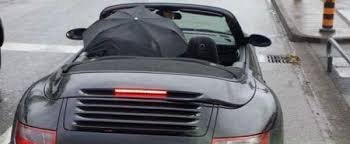How Fast Must You Drive Your Convertible To Stay Dry In The Rain?

Getting caught in the rain in a convertible with the top down is no fun at all. We've always wondered if it was possible to drive fast enough to stay dry. Drivetribe has it all figured out.
They shared their findings with us with a video posted to their YouTube channel. Mike, the host, begins by explaining the two types of airflow – laminar and turbulent. Laminar air is slow, low-pressure air, while turbulent air is fast, high-pressure air.
The layer of air that comes in contact with the body lines of a car is called the boundary layer. The top of the windshield frame, where the bodywork stops abruptly, is called the separation point. At this point, the air becomes very turbulent, and, as you go faster, the area of turbulent air above the passenger compartment increases.
Mike goes on to explain that speed at which you must drive to stay dry depends on the car's shape. Specifically, the angle of the windshield.
Cars like the Mazda Miata that have a steeper windshield can generate enough turbulence to deflect the rain at lower speeds, around 45 miles per hour or so. On the other hand, sleeker cars with windshields that are laid down nearly flat, like the Ferrari Portofino, have to go faster to achieve the same result.
Some Mercedes-Benz convertibles actually employ wind deflectors at the top of the windshield frame that resemble miniature air brakes. They work to maximize laminar air flow while keeping turbulent air flow out of the cabin. In a rain storm, they can also keep you dry.
Of course, all of this is more or less a moot point when you get to a stoplight. If you're on the highway and the rain starts falling, though, understanding air flow can help to buy you some time before you can get underneath a bridge and put the top back up.
Related News
